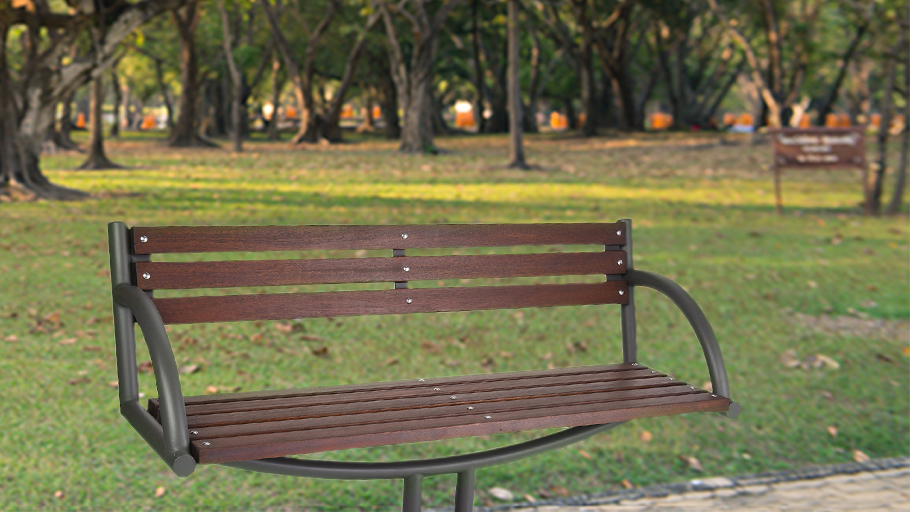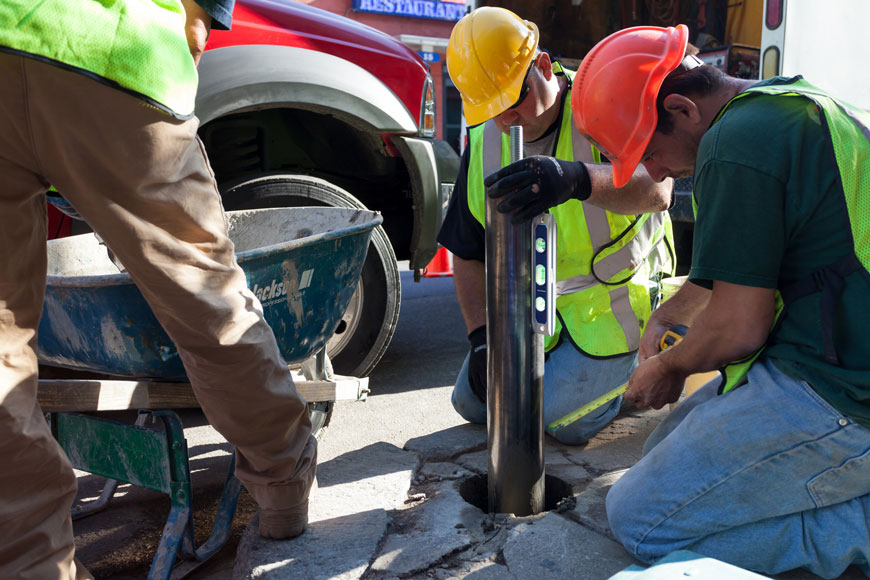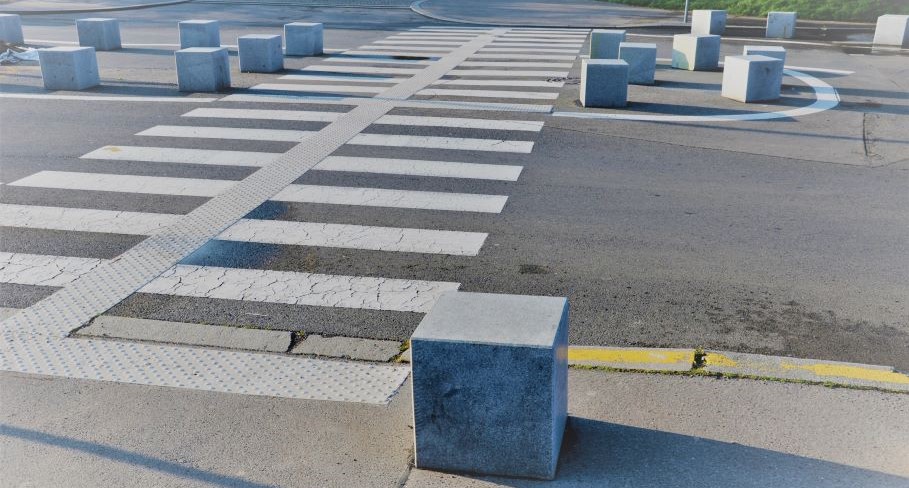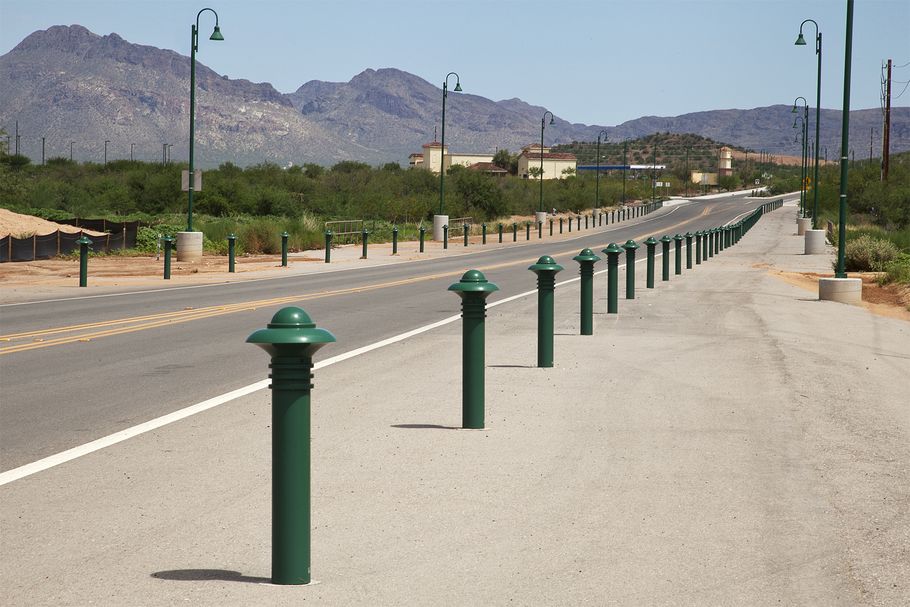Trench drains inside and out
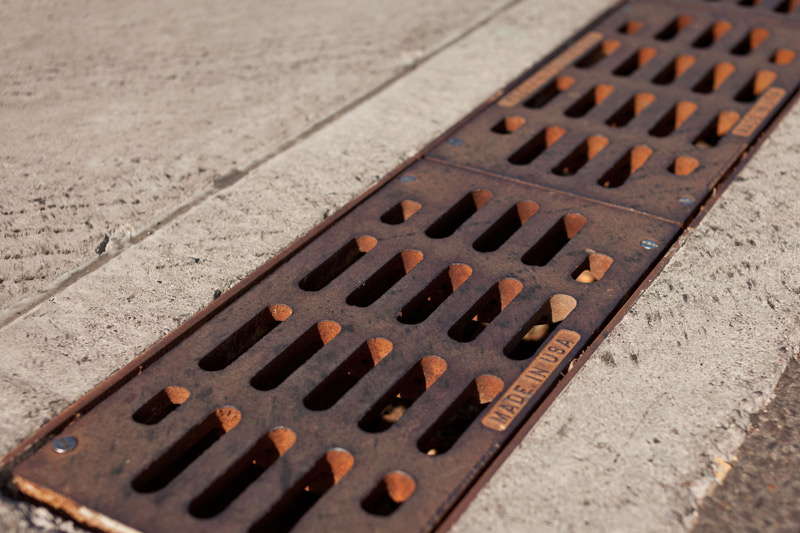
“Trench drain” refers to any narrow, long carved channel used to move water. The trough may be formed out of concrete by hand, be made out of concrete using a pre-formed mold, or be made of another material like plastic, PVC, or metal. Trench drains often have a grating on top to strain debris and prevent tripping. Many different terms are used to describe trench drains, including line drain, strip drain, linear drain, slot drain, and channel drain. These largely refer to the same thing though there are slight differences in connotation. Trench drain could be curved (although it usually isn’t, to prevent debris build up.) Linear or strip drain implies very straight trench. Slot drains are trench drains with a small aperture instead of a grate. Of all the terms, trench and channel drains are most interchangeable.
Choosing grate design for channel drains
Whether indoors or outdoors, channel drains are installed to remove water and leave a safe surface.
The size of the channel is determined by maximum expected water flow.
Functionally, grates are chosen through a combination of factors.
Expected water flow
Larger grates and larger slots move more water than small ones.
Debris filtering
Grates act as strainers that stop rubbish, leaves, or dirt from entering the channel. What level of debris filtering is necessary is in part based on likely throughput: a small drain may have a harder time clearing than a larger one.
ADA compliance
The Americans with Disabilities act requires that slots in grates are 1/2 inch or smaller, perpendicular to the main direction of travel, so they won’t catch wheelchair wheels or crutch tips.
Heel-safe or heel-proof grates
Heel-proof grates (also known as heel-safe grates) are designed to prevent high-heels from getting caught or broken. It’s an important consideration for any grate that is likely to be stepped on in high-volume pedestrian spaces. The ASME A112.6.3 standard offers the following definition: “A grate designed to resist entry of high-heeled shoes, in which the maximum grate hole size in least dimension shall be 5/16.”
Material
Grate material is chosen based on aesthetics, expected load, environmental conditions, and budget. Plastic grates may work as a soft material for bare feet around swimming pools, but plastic can’t handle the expected wear on a city street. Common materials are plastic, fiberglass, aluminum, cast iron, steel, and stainless steel.
Aesthetics
Grates can be very simple plates with slots of various sizes, or can be decorative. Architecturally designed grates can be used as an attractive border or accent.
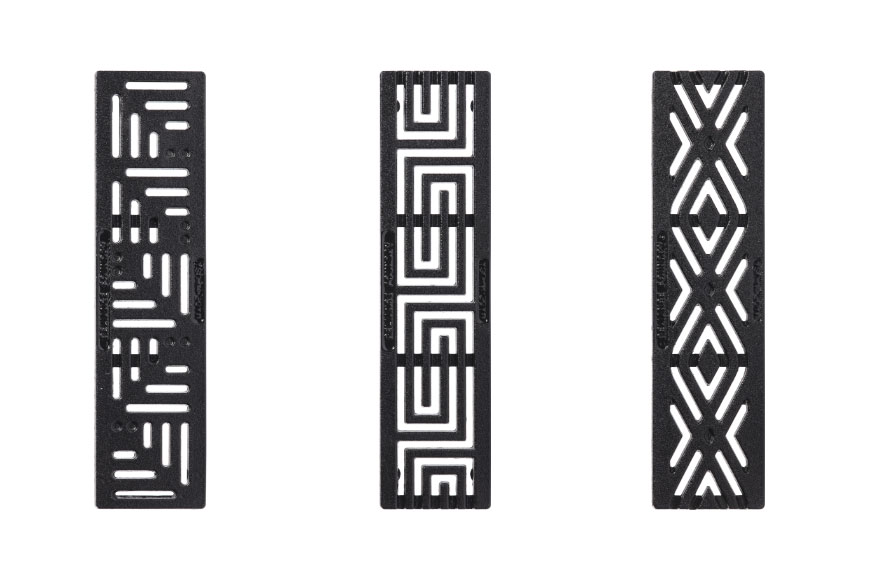
Indoor channel drain
Channel drain is often the term used for indoor, residential applications. For some customers, it sounds more appealing than “trench,” which has an industrial feel.
At the local hardware store, the DIY customer is likely to see pre-made packages described as “channel drain.” These include both a trench pan and a grate, the pan often made of plastic, acrylic, or fiberglass.
Experienced contractors have a bit more flexibility because they can custom-create channels by forming them out of concrete. Concrete-formed trenches also have more load-bearing capacity.
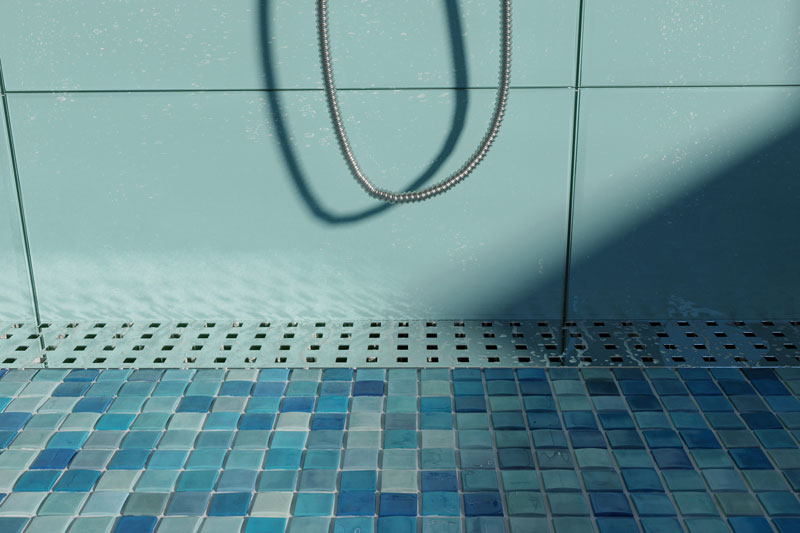
Channel drain in showers
In homes, channel drains may be built into showers as an alternative to the more common circle drain. Channel creates a pleasing border and can highlight beautiful tile. Stainless steel grates are most common. Their bright luster pops in modern bathroom design.
Channel may also be placed to help with water capture at the edge of showers. It can also sometimes be placed to manage higher-flow or wider-spread shower heads.
Although channel drain is often seen in custom shower stalls, pre-formed shower pans made of acrylic/fiberglass are beginning to offer models with these wider drains. These slots are often referred to as linear drain, to describe their shape, in comparison to more common circle or square drains.
Showers are the application least likely to use the word trench, perhaps because of associations with wet-feet during trench warfare in World War I.
Indoor pools and indoor trench drain
Indoor pools must have a water drain system to manage splashes and run-off. Since many pools are outside, where the word trench is more common, the term carries over into indoor installations. Indoor pool border drains are therefore referred to in all the possible ways: trench, channel, linear, or strip.
Slot drains are less common around pools. The aperture is small enough to not need grates in most situations, but poolside a small slot may still catch a child’s toe. Stainless steel and plastic are the most common materials used for indoor channel grates.
Channel drain in basements
When basements leak, renovations to the water management system can happen inside or outside the home. Outside, channel drain may be used near the basement wall near sidewalks or driveways, but it is uncommon under the eaves. More commonly, contractors will install weeping tile (a perforated pipe also known as a French drain), or reconfigure the downspout and eaves.
Occasionally, channel drain systems are used in basements. Usually, they will be placed near entrances or in unfinished spaces, with a sump pump installation. In finished basements, it is more common to install French drain and waterproof membrane systems under the slab. French drains can manage water from the sides and below, whereas channel is useful where there may be water incursion from above.
Public bathrooms and pool change rooms
In busy public washrooms and pool change rooms, it can be useful to have options that allow for quick cleaning and sterilization of surfaces. Channel drains allow disinfectant and water to be liberally applied to the hard surfaces within these spaces. Wet-dry spaces, like spas or pool-change-rooms, use drains to remove standing water.
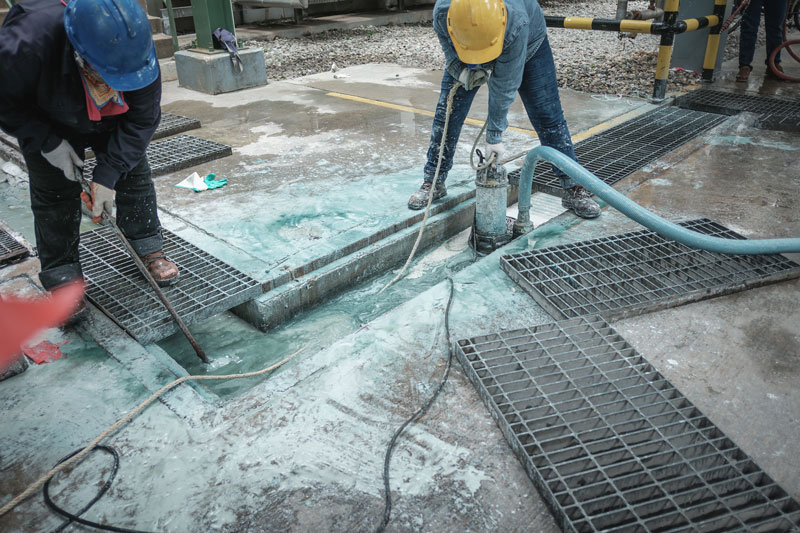
Channel drain in industrial settings
In residential indoor installations, channel drain only needs to handle the light duty of foot traffic.
Warehouses, factories, garages and hangars need heavy-duty or road-safe channel drain and grates. They are usually made of formed concrete, perhaps reinforced with rebar, and topped with structurally load bearing grating.
In warehouses, garages, and factories, channel drains are used to help with spills and cleanup. Grates need to be strong enough to manage fully loaded transport machinery and be resistant to atmospheric conditions. Food service, brewing, and chemical manufacturers often rely heavily on their channel drainage in everyday operations, allowing workers to easily hose down surfaces when needed.
Garages and hangers manage precipitation brought in from outdoor vehicles. Bus depots, auto shops, and fire stations may regularly clean vehicles while they’re in the garage. Channel drains usually manage this water flow.
Gratings in warehouses and garages must be load rated from heavy duty to special duty. Cast iron or steel are the most common materials for their strength and resilience. Special duty ratings are safe for airports, airplane hangars, and shipping areas.
Outdoor channel drain
Channel drains are an important water management tool in all sorts of outdoor capacities. As with indoors, these drains range from lighter-duty solutions to heavy-duty ones. They are also chosen based on traffic volume and type, peak water flow volumes, design features, and expense.
Outdoors at home: residential channel drain
Channel drain can help manage water around swimming pools, on decks and patios, in driveways, and in other places where water might run-off or pool. Residential buyers are often motivated by decorative features to beautify their homes. Budget and ease-of-installation also are important to homeowners.
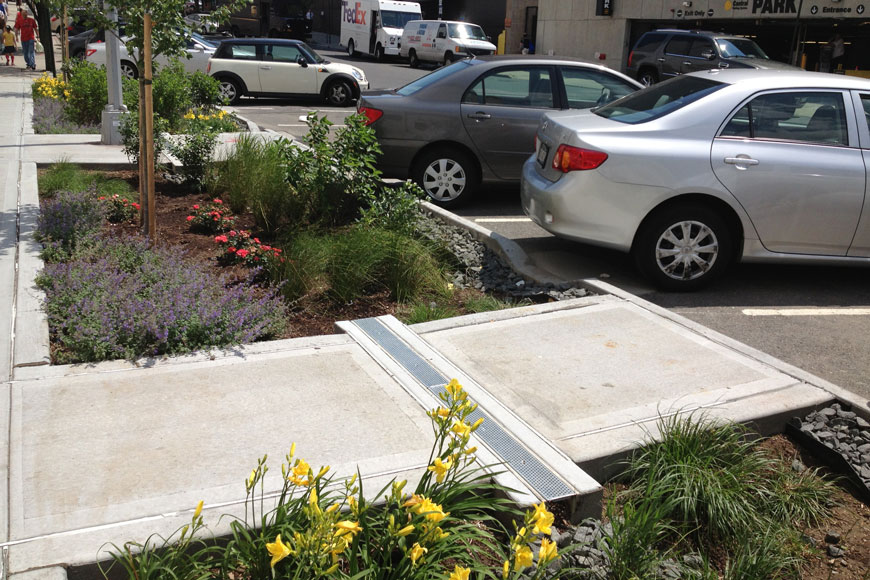
Channel drains for sidewalks and roadways
Urban environments have a lot of hardscape: concrete, asphalt, and stone. Sewer systems have traditionally managed run off in these areas, with channel drains acting as small capillaries that move water to larger sewer pipes.
To help build groundwater supply and manage flood risk, cities are increasingly relying on bioswales and permeable hardscape. Directing water flow to these areas is often facilitated with the use of channel drains.
Using channel drains in landscape
It is common to use French drains or other below-surface pipe in landscape drainage, because these drains manage water from below and the sides. However, in places where a lot of runoff or surface water must be absorbed, channel drains can help prevent the formation of mud and flooding by pulling surface water to areas that can handle greater flow.
Drainage for public pools, water features, and waterparks
Channel drain is very common around outdoor public pools. This drain is usually larger than the drain around indoor pools because it manages rain and stormwater as well as pool-water. Outdoor public pools are more likely to have heavy-duty grating made to withstand years of use, often in painted cast iron or textured steel. Waterparks often rely on channel drain around the edge of every splash zone, bringing the water back for treatment and recirculation. Public areas with water features sometimes use channel drain to help capture splash or wind-blown water.
Choosing the right drain for your project
Residential, commercial, industrial, and municipal projects all may rely on the simple channel drain to help move surface water. Each project has its own environment, functional need, budget, and aesthetic. If you’re looking for industrial or decorative channel grate out of rugged, long lasting cast iron, check out our selection of channel grate. Please feel free to get in touch with any questions you might have.

